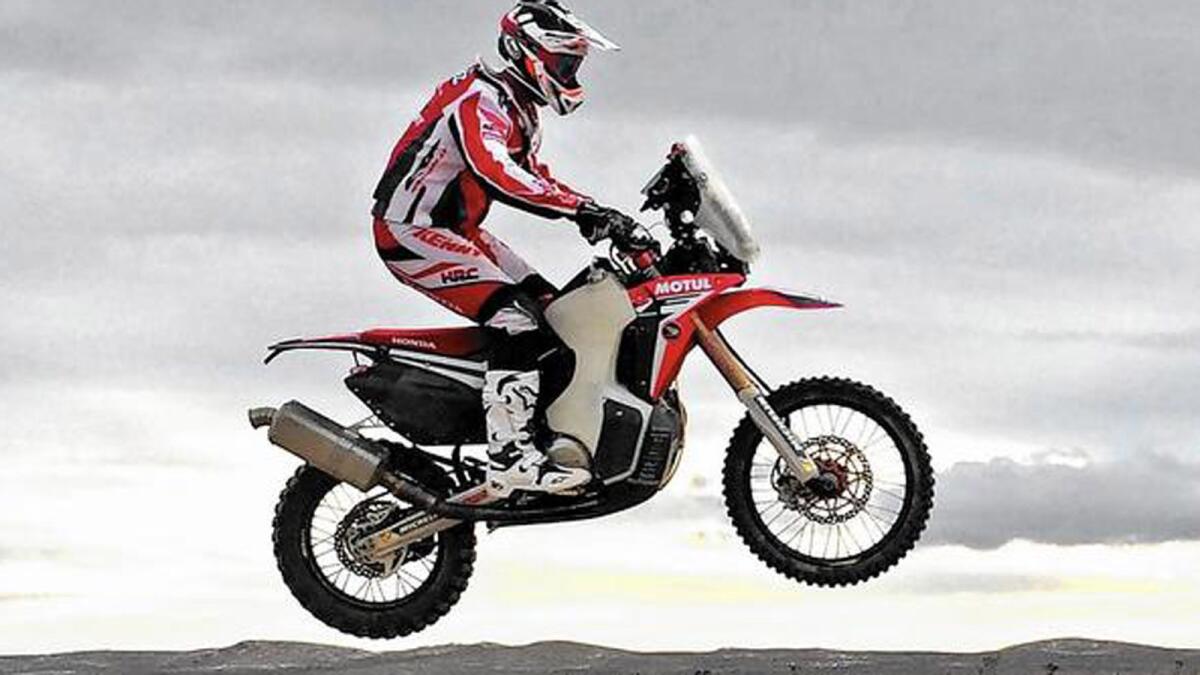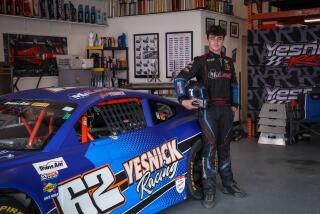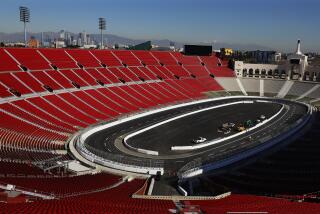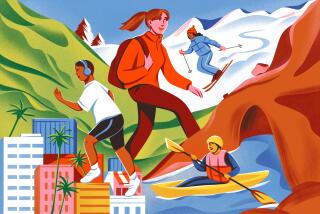American bikers prepare for Dakar Rally, the world’s most dangerous motor sports event

Dakar hopeful Ricky Brabec gets some air while training at Black Mountain Ranch off Interstate U.S. 395 in the Mojave Desert for the upcoming rally.
On Jan. 2, a “Mad Max” phalanx of 354 cars, trucks, motorcycles and quads will blast out of downtown Buenos Aires and begin the treacherous 8,000-kilometer (4,971 miles) Dakar Rally across the mountains and deserts of Argentina and Bolivia.
The annual off-road race, considered the world’s most challenging and dangerous motor sports event, is often fatal. Since its inception in 1978, the Dakar has claimed the lives of 28 participants — most of them motorcyclists.
As part of their preparation for the deadly Dakar, the five American bikers who will take part in the 2016 Dakar met recently at a ranch in the Mojave Desert for a weekend of training, pep talk and strategy.
As a longtime desert motorcycle rider, long enthralled by the Dakar mystique, I leaped at the chance to ride with them.
Under a cloudy sky that would soon produce icy rain, event organizer Quinn Cody, who suffered a near-fatal crash during the 2012 Dakar, chided a racer for worrying about the weather.
“Dude! You’re going to be riding in the rain, in 30-degree weather, at 10,000 feet elevation, in Bolivia!” he said.
Not well-known in the U.S., the Dakar is enormously popular worldwide. With live coverage on 70 broadcast networks in 190 countries, the rally is seen by more people globally than any sporting event except the Formula 1 car races. An estimated 37 million people watched the 2015 race.
Originally run from Paris to Dakar, Senegal, the rally moved to South America in 2009 after threats of terrorist attacks in Mauritania and Mali convinced organizers that they needed to leave Africa.
It is a brutal race — 14 days, in sprints of up to 600 miles a day, at speeds above 100 miles per hour, along unpaved, unmarked trails, over sand dunes, across rivers, up mountains and through one of the world’s largest salt lakes.
The hundreds of riders and drivers, following coded, hieroglyphic-like maps, must weather extreme hot and cold temperatures. Some may die of heart attacks, as was the case with Argentinian Argentine racer Jorge Martinez Boero. Some will get lost and die before being found, as happened to French rider Pascal Terry. Some may expire from injuries suffered in crashes, like Australian Andy Caldecott. Some will succumb to heatstroke or fail from dehydration, like Polish rider Michael Hernik did during the 2015 race.
“The Dakar is well-known for being the roughest race in the world,” said Xavier Gavory of Amaury Sports Organization, which manages the race and other massive sporting events, including the annual Tour De France cycling competition. “Safety is our main concern, but it’s very difficult.”
The event attracts a special kind of athlete, drawn in part by its sheer difficulty. Most are professional riders or drivers, and most are men. Only 19 of the upcoming event’s 556 competitors are women. Finishing the rugged race requires more resilience from rig and rider than any other motor sports competition.
“I like to do things that others will not try. It eats at me, the desire to do something hard,” said veteran road racer C.R. Gittere, who is attempting his first Dakar. “It keeps me awake at night, always looking to do something that others said is hard or I cannot do.”
It’s an expensive quest. The motorcycle that Gittere will race cost more than $50,000 to build and prepare. He and his fellow riders will pay close to $25,000 to enter the race, plus an additional $14,000 for the mechanics who will accompany them. Rally organizers estimate the minimum participation cost at above $75,000 per person.
A piece of the Dakar prize money can defray that. The winner in the motorcycle class will receive about $50,000. Also, major motorcycle brands typically offer sponsorships to the top riders.
“If a rider wins Dakar he is almost guaranteed to be signed by a manufacturer,” Cody said. “For the manufacturer it is mostly about bragging rights. Companies want to be able to say that they have conquered the most grueling off-road race on the planet.”
Even with those treasures at the finish line, many of the racers won’t make it to the end. Cody said the completion rate for last year’sDakar was 53%.
The Dakar training regimens are severe. Alexander Smith, son of legendary California off-road racer Malcolm Smith, began conditioning his body for the race in mid-2013 with a five-day-a-week routine that includes bicycling, rowing and swimming. (His racing partner Gittere actually moved to the desolate desert town of Pahrump, Nev., for six months, to perfect his off-road riding technique.)
“I don’t think anyone is ever ready for Dakar,” said Smith, 30, who is backed by KTM-owned Husqvarna. “But I’m fairly confident. I’m in great shape to ride a motorcycle 6,000 miles.”
All of the American riders had come to the Mojave’s Black Mountain Ranch to navigate through a rugged 84-kilometer course laid out by Cody. Joining Smith and Gittere were young riders Ricky Brabec, Ian Blythe and Scott Bright. The Dakar hopefuls and about 40 other riders rolled out of the temporary desert bivouac astride their purpose-built bikes. .
Prepared for Dakar, the machines were all equipped with massive, oversize gas tanks — to help them cover extreme distances without fuel stops — and each carried the mandatory three liters of drinking water to help riders with heat and dehydration in the event of a breakdown.
After a few miles in the desert, I had a clearer understanding of the physical challenges. The Dakar machines are almost twice as heavy as average off-road motorcycles. Despite decades of desert experience, I was soon wearied by maneuvering them in and out of deep sand washes.
I also learned to appreciate the difficulties of navigating, off-road, at speed, across unfamiliar terrain.
The Dakar bikes were all outfitted with special navigation towers containing compass, GPS location finder, digital odometer and the push-button-electric spindle that advances the paper “road books” — the custom-made maps that are the riders’ only hope of finding their way back to camp.
Dakar competitors will get a fresh map every night, covering the next day’s ride. Conscientious riders will spend hours using colored marking pens to highlight the map’s most important details.
“Remember, speed is not the first priority,” Cody reminded the riders. “Getting there is the priority. Pay attention, stay alert and don’t get lost. And go fast if you can.”
The road books, due to their Paris-Dakar race origins, are written in a strange French-Arabic patois. “AG” means “a gauche,” or to the left. “TD” means “tout droite,” or straight ahead. A solid line indicates a trail, a broken line a faint trail. Two exclamation points and something resembling a flying sea gull means that there is a very big ditch dead ahead.
Each piece of information is accompanied by an odometer reading, in kilometers. Many are also accompanied by a compass heading. Using all the available information, plus a keen eye and innate sense of direction, riders were told, should guarantee that everyone would return to camp before nightfall.
Riding in pairs, Smith, Gittere and Brabec and their day’s riding partners blew across the desert. For the next several hours, Dakar pros and amateurs got stuck in the deep sand, wandered too far up dry washes, overshot turns onto faint trails or drifted off course by misreading compass headings.
At times, the route took them up sand dunes or steep, rocky hillsides. At others, the road book sent them over miles of open desert, with no landmark but a compass heading to guide the way.
The terrain, similar to what competitors could expect in parts of South America, was taxing, as the riders muscled the 400-pound motorcycles over the uneven, uncertain ground.
When the 84-kilometer route was completed, I was knackered. And impressed. The Dakar riders would be riding 10 times that far, often over more difficult terrain in more difficult conditions, every day -- for 14 days straight. And trying to beat other riders while doing so.
Smith looked hardly winded. Wearing the wide grin that was his father’s signature, the young rider said, “That was fun!”
Though he was appropriately concerned about some of the longer Dakar stages, Smith said he was eager to get to Argentina and start racing.
“Dakar is going to be pretty tough,” he said. “There will be some long days and many chances to screw up.”







